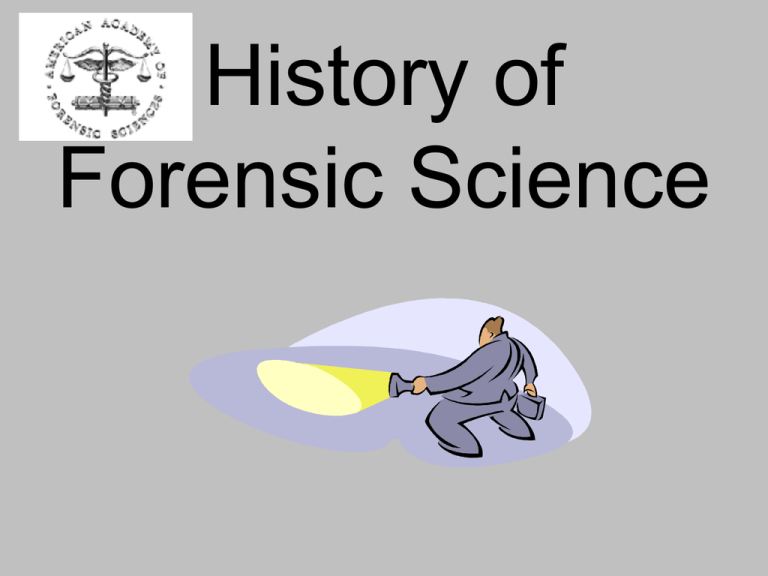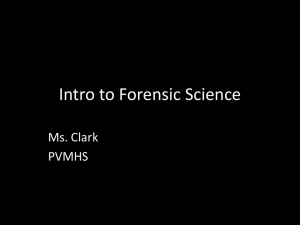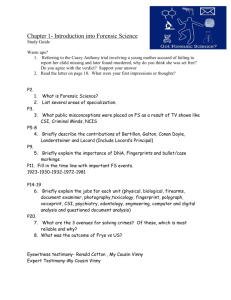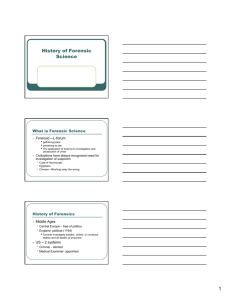History- cartoony intro with Bertillon and fingerprinting
advertisement

History of Forensic Science Ancient Rome • • “Forensic” derived from the Latin word “forensis” which means forum • Accused and Accuser argued their cases before a chosen group of people • The individual with the best argument and delivery (in other words, the best forensic skills) won! Archimedes (287-212 BCE) • Archimedes used water displacement and proved that the King’s crown was not made of solid gold by its density and bouyancy. • This “Eureka” moment is considered to be the earliest account of forensic science. Nero’s Wife (66 CE) • In 66 CE Nero murdered his wife and his mistress identified the wife’s head by the two discolored front teeth. This is the first account of forensic odontology. 3rd Century China- An Early Forensic Investigation • A woman claimed that her husband died in an accidental fire. The local death investigator noticed that the husband’s corpse did not have ashes in its mouth. In order to verify the woman’s story he burned two pigs-one alive and one dead. He then checked the mouths of each pig for ashes. The pig that was burned alive had ashes in its mouth, but the other pig did not. This proved that the man was dead before he was burned. When confronted with the evidence, the woman confessed to the murder. Fingerprints • Soleiman, an Arabic merchant of the 7th century used fingerprints as a proof of validity between debtors and lenders. The crowner’s job was created in 1149 by King Richard I to determine how much an estate owed to the crown. Later the crowner was called upon to investigate questionable deaths. The title of crowner eventually evolved into coroner. Entomology • 12th century China- A case of a person murdered by a sickle was solved when the death investigator instructed everyone in the town to bring their sickles to one location and …. Entomology (cont) • …flies, attracted by the smell of blood, eventually gathered on a single sickle. In light of this, the murderer confessed. Watch of London and “Old Charleys” • The first police were appointed by Henry III in 1253. They worked only at night. They were known as the Watch of London. • Later, they became known as Old Charleys and were paid by the residents they served. Autopsy • The word "autopsy" comes from the Greek words "auto" and "opsis", and it literally means "to see for oneself". • The first known legal autopsy was ordered by a magistrate in Bologna in 1302. • To understand the human anatomy better, and to improve their skills, the artists Leonardo da Vinci and Michelangelo each performed autopsies. • The autopsy really became significant in 1761, when Giovanni Morganni published his great work On the Seats and Causes of Diseases as Investigated by Anatomy. Richard Hunne and Blood as Evidence • 1511- Hunne questioned the use of ecclesiastical law vs. civil law. • He was imprisoned for heresy. • When he was found dead in his cell, the prison claimed that he had committed suicide. However, blood evidence proved that he had been murdered. Colonial America (1609-1664) • The Night or Rattle Watch was initially created to watch for fires, but eventually began to watch for criminal activity also. • Members carried wooden rattles to alert the people if a fire or crime was occurring. 1670: Anton Van Leeuwenhoek Constructs a simple microscope that he presents to The Royal Society Why was this important? • The development of increasingly more powerful microscopes paved the way for the study of Microscopy which has become essential in the field of Forensics…what uses can you think of…what investigations would utilize this technology? 1776 Colonial America The body of General Warren was disinterred from a mass grave and identified by Paul Revere. Revere recognized the false teeth that he had made for the General. First Documented Use of Physical Evidence In 1784, an Englishman was convicted of murder. A torn piece of newspaper that was retrieved from the victim’s head wound matched a piece in the Englishman’s pocket. Europe’s Industrial Revolution (18th Century) • The populations of the towns increased and so did the crime rate. • Thief catchers were recruited. These were criminals that agreed to implicate their accomplices for money or social status. Thus the phrase “set a thief to catch a thief”. The Bow Street Runners of London • Henry Fielding, a resident of Bow Street, developed the first investigative team in the 1750’s. • The Bow Street Runners earned a commission from the stolen goods that they recovered. • In 1792, an Act of Parliament allowed the runners to help outside the London jurisdiction. This established the model for Scotland Yard. Paris, France-1810 • The first detective force, the Surete, is established. Mathiew Orfila • Orfila is known as the Father of Toxicology • He published a book on poisoning in 1813. The Texas Rangers • Established in 1823 by Stephen Austin to protect the settlers in Texas. • They are the oldest law enforcement agency in North America. "They were men who could not be stampeded." Colonel Garrison Murder for Medicine • In Edinburgh, the demand for bodies led to “murder for medicine” • Burke and Hare became known as the first serial murderers after they killed 16 people and sold the bodies to John Knox, the local anatomist. London Metropolitan Police Force 1829 • This agency was founded by Sir Robert Peel. • They were nicknamed “bobbies”. • They were the first fulltime police force to have minimum weight and height requirements with standards for literacy and competency. The “bobbies” The Marsh Test • Arsenic, also known as inheritance powder, was a popular method of murder among royalty. • In 1836 Marsh developed a chemical test to detect arsenic. • In 1840 the test was used to convict Marie Lafarge of poisoning her husband. America- Middle of the 19th Century • First professional police forces: – Boston in 1837 – New York in 1844 – Philadelphia in 1857 – All major cities by 1870’s The Pinkerton Agency • In 1850, Allan Pinkerton established Pinkerton’s National Detective Agency. • They were asked by local police to help in investigations. • They created a Rogues’ Gallery- a compilation of descriptions, methods of operation, hiding places, and associates for known criminals. This was the precursor to mugshots and Most Wanted Lists. • Pinkerton gained national fame when he uncovered a plot to kill Lincoln in 1861. He subsequently became the head of Secret Services during the civil war. Pinkerton’s “private eye” Logo William Herschel- 1856 Herschel, working in India, uses thumbprints on documents to identify workers. The Secret Service • The Secret Service was created on July 5, 1865 in Washington, D.C., to suppress counterfeit currency. • Two years later, the Secret Service responsibilities were broadened to include "detecting persons perpetrating frauds against the government." • In 1894, the Secret Service began part-time protection of President Cleveland. • In 1902, one year after the assassination of President McKinley, the Secret Service began to protect the President on a full-time basis. The Main Duties of the Secret Service Alphonse Bertillon • In 1879 Bertillon develops a system to identify people using measurements. • He named the system anthropometry. • For two decades, this system was considered full proof. The Required Measurements of the Bertillon System Forensics in Literature • Sir Arthur Conan Doyle was a physician that had an unsuccessful practice. • He used his role model Professor Bell as a template for Sherlock Holmes. Bell had excellent deductive reasoning skills. • 1887- A Study in Scarlet was the first Holmes story. • It was published in Beeton’s Christmas Annual. • In 2007, a copy of Beeton’s sold at auction for $156,000 Sherlock Holmes • Holmes eventually starred in 60 works (4 novels and 56 short stories) • The character lived at 221B Baker Street. This was a fictional address, but so many readers tried to find Holmes’ residence that England created a 221B Baker Street. • Holmes’ arch enemy was Professor Moriarty. • Doyle killed off the character of Holmes in 1893. The outrage was so great that Doyle was forced to bring him back. A Letter from a Fan 1888 and the Kodak Camera • George Eastman invents the first handheld camera. He names the brand Kodak and sells it for $25.00. 1892- Francis Galton • Galton, a nephew of Charles Darwin, was the first to state that fingerprints are unique to each person. • His suggestion to use fingerprints for identification was not taken seriously until the Bertillon System failed. 1900- Scotland Yard • In 1900, Scotland Yard replaced the Bertillon System with a fingerprint identification system. • The Metropolitan Police's crime database is housed at New Scotland Yard. The system is called Home Office Large Major Enquiry System, more commonly referred to by its acronym, HOLMES. The training program is called "Elementary", after Holmes's well-known phrase "elementary, my dear Watson". Karl Landsteiner • In 1900, Landsteiner identifies human blood groups. • He will receive the Nobel Prize in 1930 for this discovery. The West Case • In 1903, Will West was arrested and taken to Fort Leavenworth prison. His measurements were taken using the Bertillon system and it was soon discovered that they matched another inmate, William West. Will and William were identical twins, but their fingerprints were different. This case marked the end of the Bertillon System and all subsequent identification was done using fingerprints. The Locard Principle • In 1904, Edmond Locard established the principle that “every contact leaves a trace”. • This is also called the exchange principle. The FBI • In 1905, President Theodore Roosevelt established the Federal Bureau of Investigation. The First Crime Lab in the World • In 1910, the first crime laboratory was opened by Locard. • The lab was located in France. Soil as Evidence • In 1910, George Popp uses soil evidence to solve a murder case. • Other botanicals were also used to strengthen the case. 1923 Developments • The first police lab is created in the United States. The lab is located in Los Angeles. • Frye vs. The United States established the concept of general acceptance for evidence presented in court. • Francis Aston receives the Nobel Prize for the development of the mass spectrometer. Calvin Goddard • In 1925, Calvin Goddard wrote a paper about the use of a comparison microscope in ballistic investigation. • He later worked with the police to determine that the St. Valentine’s Day Massacre was the work of Al Capone’s gang. He was able to match the bullets to their Tommy guns. FBI Crime Laboratory • The FBI opened its first national crime lab in 1932. The lab offered services to all law enforcement agencies in the country. • The lab was located in Washington, D.C. and performed 963 examinations during its first year of existence. The 1950’s • In 1954, Borkenstein invents the Breathalyzer for field sobriety testing. • Forensic anthropology is formed when growth stages of skeletal bones is discovered. • In 1959, Watson and Crick discover that DNA has a double-helix shape. Developments in the 1970’s • Japan discovers that Superglue fumes will develop fingerprints. • The FBI creates a fingerprint database. • Psychological profiling begins. • Bite mark evidence convicts the serial killer Ted Bundy. DNA Fingerprinting • In 1984, Alec Jefferies discovers that everyone, except identical twins, has unique DNA • In 1987, DNA fingerprinting is used to convict Colin Pitchfork of murder. • In 1998, an FBI DNA database is created. Richard Saferstein discusses the history of CSI • Listen to the author of your textbook discuss the history of CSI. • http://www.videojug.com/interview/earlyhistory-of-csi-2 The Future of Forensic Science • The field of Forensic Science is constantly changing as new technologies are discovered. • The fascination with CSI is just getting started!







